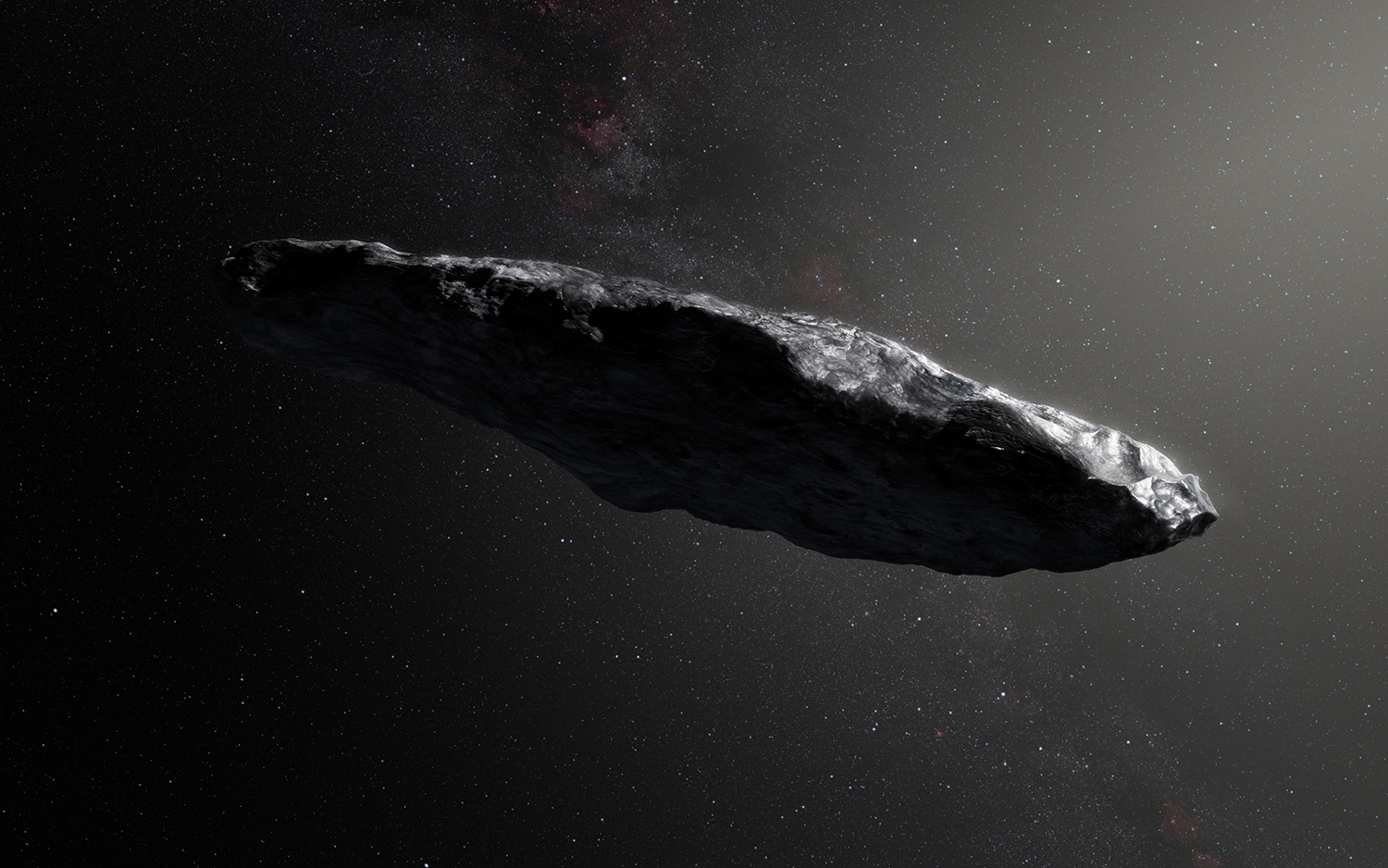Harvard Scientists Say Aliens May Explain Bizarre Interstellar Object 'Oumuamua (But Probably Not)

Oddball space rock 'Oumuamua, discovered over a year ago, is the first interstellar object to visit our solar system and is unlike any comet or asteroid observed before. But does that mean that intelligent aliens created it? A new study examining 'Oumuamua's orbit hints that they might have.
Two astronomers with the Harvard-Smithsonian Center for Astrophysics (CfA) recently took a closer look at the cigar-shaped object's unusual acceleration during its trip through our solar system, to figure out what may have caused the unexpected boost in the object's motion.
Such acceleration during orbit is characteristic of comets, because their icy bodies evaporate, expelling water vapor that propels the objects. But prior analysis of 'Oumuamua (which means "messenger from afar arriving first" in Hawaiian) suggested that the strange object was no comet. This implies that other factors shaped 'Oumuamua's trajectory, the scientists reported in a new study.
They found that pressure from solar radiation could propel 'Oumuamua if the object — or part of it — is thin enough and strong enough to act as a type of "light sail," which generates propulsion using solar energy. Such a structure could have formed naturally, but it could also represent "a light sail of artificial origin" crafted by intelligent extraterrestrials, the researchers wrote. [9 Strange, Scientific Excuses for Why We Haven't Found Alien Life Yet]
However, that conclusion is just one of the possibilities presented in the new study, published online Oct. 26 in the preprint journal arXiv and submitted to The Astrophysical Journal Letters.
Even when 'Oumuamua still resided in our cosmic neighborhood — it has now zipped beyond the reach of our telescopes — scientists were investigating if it might represent an alien spacecraft. Astronomers in Australia pointed a powerful telescope at the 1,300-foot-long (400 meters) 'Oumuamua to see if they could detect radio transmissions that would indicate signs of life on board the object (or ship). But only silence came back from 'Oumuamua, Live Science previously reported.
As the visiting 'Oumuamua left our solar system, images showed that the object was speeding up. But other images captured as 'Oumuamua passed close to the sun showed no trailing tail and no halo of vapor — something that astronomers would expect to see in a water-releasing comet, the researchers wrote. Vapor off-gassing when a comet swings close by the sun also affects such an object's spin, but 'Oumuamua's spin appeared unchanged as it accelerated. Whatever 'Oumuamua is, it certainly didn't behave like a comet, the study authors reported.
Sign up for the Live Science daily newsletter now
Get the world’s most fascinating discoveries delivered straight to your inbox.
But if 'Oumuamua didn't get a boost from evaporating ice, how did the object speed up? The likeliest explanation is solar radiation pressure — the force applied to an object's surface by sunlight — with 'Oumuamua acting as a "solar sail," the study said.
For that to work, the researchers calculated, the so-called sail would have to be thin enough to respond to the pressures of radiation, yet durable enough to travel great distances and withstand the wear and tear that comes with flying through space. The scientists calculated that a solar sail with a thickness of about 0.01 to 0.04 inches (0.3 to 0.9 millimeters) could survive the inevitable collisions and erosion that 'Oumuamua likely encountered during its long journey.
"If radiation pressure is the accelerating force, then 'Oumuamua represents a new class of thin interstellar material," the scientists said.
As to what may have produced this previously unseen material, it could have emerged naturally from the debris of a planet-forming disk in a distant solar system going "through a yet-unknown process," the study authors suggested.
But there's also a chance that 'Oumuamua's novel structure was crafted deliberately, the researchers added. One possible scenario is that 'Oumuamua is a bit of light-sail debris broken off from an advanced form of extraterrestrial technology, drifting aimlessly in space.
Or maybe it was sent here on purpose, the scientists added.
"A more exotic scenario is that 'Oumuamua may be a fully operational probe sent intentionally to Earth vicinity by an alien civilization," the study authors wrote.
Because the opportunity to capture images or samples of 'Oumuamua is long gone, "its likely origin and mechanical properties could only be deciphered by searching for other objects of its type in the future," the researchers concluded.
Originally published on Live Science.

Mindy Weisberger is an editor at Scholastic and a former Live Science channel editor and senior writer. She has reported on general science, covering climate change, paleontology, biology and space. Mindy studied film at Columbia University; prior to Live Science she produced, wrote and directed media for the American Museum of Natural History in New York City. Her videos about dinosaurs, astrophysics, biodiversity and evolution appear in museums and science centers worldwide, earning awards such as the CINE Golden Eagle and the Communicator Award of Excellence. Her writing has also appeared in Scientific American, The Washington Post and How It Works Magazine. Her book "Rise of the Zombie Bugs: The Surprising Science of Parasitic Mind Control" will be published in spring 2025 by Johns Hopkins University Press.










